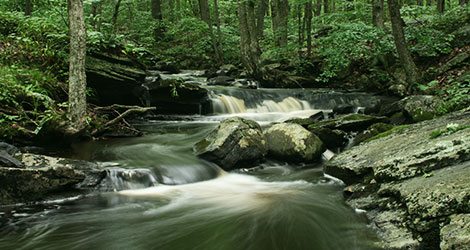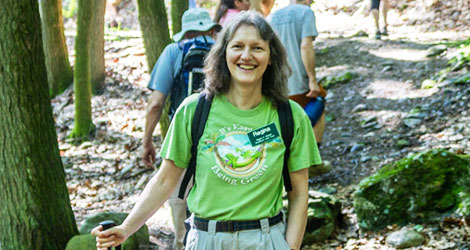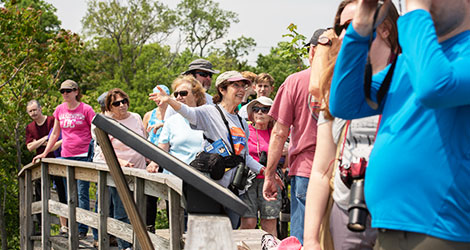Property Management & Forestry Resources
The Connecticut Forest & Park Association (CFPA) prides itself on being a statewide leader in forest and trail conservation and the best way to lead is by example.
With the help of volunteers and consultants, CFPA manages over 400 acres of forested property, monitors another 1,800 acres of conservation easements, and maintains over 825 miles of trails. We can help on a wide array of conservation topics and if one of our dedicated staff cannot help, we can point you in the right direction. Most of these links are to partner websites, which may occasionally change so be sure to notify us if you come across any broken links or access issues while using this page.
The Basics
- Basic Forestry Terms – Common forestry terms for the beginner.
- Silvics of North America – Plant list and information about all commercial species in North America.
- Virginia Tech Dendrology – Tree identification resource with fact sheets and photos.
- USDA Plants Database – Easily searchable database with factsheets about plants across the U.S.
- Introduction to Forest Ecology and Silviculture – A great introductory book that discusses the basics of forestry and timber harvesting.
- Reading the Forested Landscape: A Natural History of New England – A wonderful book with insights into features of New England’s woodlands.
- Using a Biltmore Stick for Measuring Volume of a Standing Tree – Easy to understand resource for measuring trees.
- Conducting a Simple Timber Inventory – Great resource for learning the concept of doing a timber inventory.
General Forestry Resources
- History of CT Forests – Background information about CT forests.
- Why We Cut Trees – State forestry resource explaining the benefits of cutting trees.
- Ever Thought of Selling Timber? – Resource highlighting what to consider when selling timber in CT.
- Timber Harvest Primer for Landowners – Great resource from Wisconsin about things to think about when harvesting timber.
- CT Forest Regeneration Handbook – Resource describing the different types of forest management.
- CT Forest Action Plan – Statewide forest assessment and strategy.
- State Forestry Publications Page – Various state published resources on forestry and timber harvesting.
- CT Grown Forest Products – Information about the CT Grown forest products program.
- Economic Importance of CT’s Forest Based Economy – 2015 report highlighting the value of forestry in CT’s economy
- Understanding Connecticut Woodland Owners – A report on the attitudes, values and challenges of CT’s family woodland owners.
- Forest Connect – Cornell sponsored woodland owners website with webinars, publications, etc.
- Northern Woodlands Magazine – Magazine for woodland landowners with information about management and current issues.
- The Place You Call Home – A CT specific Northern Woodlands Magazine special edition.
- CT Woodlands Magazine – CFPA’s sponsored magazine discussing forestry & trail issues in Connecticut.
Climate Change Resources
- Climate Change Response Framework – Website focused on integrating climate change considerations into land management.
- Climate Change Projections for Individual Tree Species – Resource to better understand how the trees on your land might fare with climate change.
- Forest Carbon – A great resource out of UMass and the University of Vermont about forests as a natural solution for climate change.
- Northern Institute of Applied Climate Science (NIACS) – Website with various resources on climate change.
State Programs & Resources
- Tax Classification of Land as Forest Land – A program that allows forest landowners to classify their land at its current use instead of at its potential as development land, which helps reduce the amount of taxes landowners pay.
- Connecticut Master Woodland Manager – A year-long program that provides woodland management knowledge and skills through both virtual and field learning opportunities.
- State Service Foresters – A program that allows a forest landowner to request a state forester to come out and walk their property for free to learn about the resources and options available to them.
- UCONN Extension Forestry – Provides education to landowners, municipals owners, public about forestry in CT.
Young Forest Resources
- A Landowner’s Guide to New England Cottontail Management – Detailed guide about New England’s only native rabbit and its habitat requirements.
- CT Young Forest Initiative – CT’s efforts to restore young forest habitats.
- Talking about Young Forests – Guidebook for explaining the importance of young forests to the public.
Funding Opportunities
- NRCS Service Center Locations – The Natural Resource Conservation Service offers grant opportunities for landowners. Visit or call a local office to find out if you qualify.
- EQIP Funding Program Info – Helps fund forest management plans and aspects of the forest management process.
Finding Professionals
- CT Certified Foresters Directory – Connecticut has a growing list of certified foresters who can be hired to write management plans and manage timber harvest operations.
- Technical Service Providers – If you apply for funding through NRCS programs a technical service provider might be required to carry out your management work.
- CT Agricultural Experiment Station – Researchers can help identify invasive plants and insects and provide a wide array of information regarding ecosystems across CT.
Mapping Resources
- CT Eco Mapping Resource – State website for mapping data and online tools.
- MAGIC Mapping Data – Online source for CT GIS mapping data.
- CT DEEP GIS Data – Online source for CT DEEP sponsored GIS data.
- CLEAR Mapping Resources – State website for data, mapping tools, and training.
- Aerial Photos/Surveys – CT State Library historical aerial photo collections.
Management Plan Development
- Developing a Wildlife Management Plan – Good resource discussing the basics of writing a management plan.
- State Forest Management Plan Example – Example management plan from Goodwin State Forest.
- CFPA Field Forest Management Plan Example – Example management plan from CFPA’s Field Forest in Durham.
- CFPA Caron Forest Management Plan Example – Example management plan from CFPA’s Caron Forest in Stonington.
- CFPA Clemence Forest Management Plan Example – Example management plan from CFPA’s Clemence Forest in Ashford.
Wildlife Resources
- State Wildlife Publications and Fact Sheets – Various resources about CT’s wildlife species and habitats.
- Natural Diversity Database – Online resource for information about endangered and threatened species in CT.
- Managing Grasslands, Shrublands, and Young Forests for Wildlife – Book with contributions from various New England wildlife managers detailing different techniques for managing various habitats.
- Forest Bird Habitat Assessments – CT Audubon, the CT Agricultural Experiment Station, and Ferruci and Walicki, LLC are teaming up to do bird habitat assessments on private forest land across CT.
- Habitat Management Guidelines for Amphibians and Reptiles of the Northeast – Great information about amphibians and reptiles across the Northeast.
- Enhancing Your Backyard Habitat for Wildlife – Great short pamphlet about things you can do for wildlife at home.
Invasive Species Resources
Invasive species are those that are alien to the ecosystem in which they have been introduced and whose introduction causes or is likely to cause harm to the environment or human health. Many of these species have no natural enemies in our landscape and can out-compete and displace native species.
- Connecticut Invasive Plants Working Group (CIPWG) – Group working on invasive plant species issues across CT.
- CIPWG: 2025 Invasive Plant Guide– Guide to identification and control of common CT invasive plants
- Invasive Plant Atlas of New England – Maps and invasive plant species information across New England.
- CT’s Invasive Plants List – Updated list of invasive plants in CT with pictures and fact sheets.
- CT DEEP Invasive Species Resources – List of invasive species resources including invertebrates and aquatic invasives.
- Emerald Ash Borer – CT state resource page for the invasive insect Emerald Ash Borer.
- Asian Longhorned Beetle – CT state resource page for the invasive insect Asian Longhorned Beetle
Land Conservation Resources
- Starting the Land Protection Process – Brochure to help get people started in the land protection process.
- CLCC – Connecticut Land Conservation Council is a statewide group dedicated to working with land trusts across the state to increase the pace of conservation and improve the protection of all open space lands in CT.
- Landowners Guide to Forest and Trail Conservation – CFPA Brochure highlighting the why and how of land conservation.
Teacher & Outreach Resources
- Project Learning Tree – Wonderful environmental education program co-coordinated by CFPA in CT.
- Teaching Youth about Forest Stewardship – Penn State publication highlighting a way to do outreach with youth.
- Nature Activities for Families – Fun, easy-to-do activities for family hikes.
- Natural Inquirer – Middle school science education journal.
- Nature Bridge – Website with teacher resources, tools, and lesson plans focused on environmental education.
- North American Association of Environmental Education – National partner focused on environmental education
- Last Child in the Woods – Wonderful book about the importance of getting kids outdoors




